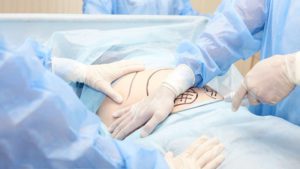Dr Barretts Tips for The Ultimate Brazilian Butt Lift Recovery
Congratulations! We’re sure you’re feeling pretty uncomfortable right now, but rest assured: you’re on your way to your new self! But first. you’re going to
Receive FREE UPS® Ground delivery for domestic orders over $200!

Breast reduction surgery can be one of the most impactful and rewarding operations. The surgery remedies the frustrating symptoms that sometimes come with large breasts, including back pain, numbness, poor posture, and irritation. During the operation, the surgeon creates incisions around the areolas and vertically beneath the bottom of the breast. Next, tissue and excess skin are removed from the breast and bra-line area to create the desired size and shape. To close the incisions, the surgeon will use a unique layered suturing technique that minimizes tension and scarring.
Though patients often feel immediate relief after their reduction and will look forward to bra shopping for their new size, it’s important to be diligent during the post-operational recovery period to optimize final results. Patients can expect to feel bruising and swelling in their breasts, especially at the incision sites, for the first few days following surgery. Rippling is common and shouldn’t be a cause for alarm. Signs of complications to monitor for are changes in nipple appearance, color, and temperature. Cold, dark nipples are an indicator of possible necrosis and should be addressed immediately. Stitches will be removed at weeks one and two, then incisions will be taped for the next six weeks.
For the first three days of recovery patients must prepare for total downtime, making arrangements for child or pet care and taking time off of work. Light walking is encouraged to promote blood flow. However, patients should avoid raising their heart rates for the first three days. Some exercise can be resumed within two weeks, but avoid any upper body workouts and anything that involves bouncing or heavy lifting for at least four weeks to give the breasts sufficient time to heal fully. Most patients return to work within a week, and more strenuous activity should be restricted for six weeks. The surgeon will provide specific instructions for optimal post-operative care, including an advanced scar management protocol after the initial healing period. For the first three nights, patients should sleep with their back upright to help some of the initial swelling go down. After that, patients may sleep flat on their back but still need to avoid sleeping on their side until day seven. At six weeks post-op it’s finally safe to sleep on the stomach.
During the healing period, patients are expected to wear loose-fitting clothing to support blood circulation and allow enough blood flow to the breasts. Doctors recommend not wearing bras until given explicit clearance by your surgeon. This is a time for patients to relax and heal while enjoying the relief that comes with their new, more manageable cup size. Lots of rest and care are the best way to ensure optimal results while minimizing the risk of complications.
Speak up if you’re unsure or curious about any part of the procedure or recovery period. Your surgical team is there to support you, and you should feel comfortable to reach out if you are concerned about complications. Cold, dark nipples are an indicator of possible necrosis and should be addressed immediately.
Here are other reasons to reach out to the surgeon:
It’s essential to keep your body in optimal health as it recovers, and smoking and alcohol can compromise the immune system.
Taking the full course of prescribed antibiotics is a MUST, and the only way to avoid infection. Pain management medication should always be taken as instructed.
Many patients find that creating a kit with everything needed for post-op may relieve anxiety and prepare them for successful healing. Breast reduction recovery supplies can be anything that will make the patient’s recovery journey as comfortable as possible. Common items to include in the kit are loose-fitting clothing, sleep aids, water bottles, nutritional supplements, scar tape, bandages, and all prescribed medications (which should be filled prior to surgery) or natural pain relief.
Starting the day of surgery, light walking about three times daily will help blood circulation, reducing the chance of clotting. More rigorous exercise can begin after about six weeks.
Once the incision sites heal and the surgeon gives clearance, many patients find it helpful to massage the scar tissue to remove built-up collagen and ease soreness. Scar creams and oils also assist in reducing any itching and preventing a prominent scar from forming.
Patients should avoid baths, hot tubs, pools, and natural bodies of water to avoid bacteria that may cause infection.
Though patients shouldn’t take baths, keeping the surgical sites clean and dry is imperative. Patients will need to shower 24 hours after their operation. Your doctor will specify how to clean the wounds and reapply bandages or scar tape.
Put your bra aside for at least two weeks or until your surgeon gives you the OK at your post-op visit. It’s important to encourage blood flow to the breasts.
Make sure to use both hands if you have to lift anything eight pounds or lighter. Avoid upper body workouts for the first six weeks.
It’s natural to be hypervigilant about all discomfort after an operation, but it’s important to remember that some sensations are normal and will usually subside after six weeks. Nipple numbness, sensitivity, or hypersensitivity will start normalizing as you progress in your breast augmentation recovery and may take up to six months to ease.
Many people are tempted to use the recovery period as a mini vacation. While resting and relaxing during this time is important, basic nutrition and wellness are even more of a priority than normal. Any major surgery depletes the body’s nutrients by responding to the wounds, so patients should try and maintain a healthy diet filled with vitamins and nutrients. Speak with your doctor about nutritional supplements like magnesium, vitamin A, vitamin B12, iron, and zinc that can assist in the healing process.
Congratulations! We’re sure you’re feeling pretty uncomfortable right now, but rest assured: you’re on your way to your new self! But first. you’re going to
Whether it’s elective or not, inflammation or swelling after surgery is a reality anytime you go under the knife. Inflammation, which is actually an inflammatory

When it comes to any surgery, planning for after the procedure is the answer to a speedy and comfortable recovery. Preparing ahead helps to reduce stress. Taking


Congratulations! You’ve just made a life-changing decision to look and feel your best, and you’re on your way to your new self! But you’re going


Congratulations! We’re sure you’re feeling pretty uncomfortable right now, but rest assured: you’re on your way to your new self! But you’re going to go


For some, making the decision to change their body through breast reduction surgery is an easy one; for others, there can be months or even years of
Always consult with your physician before using
any of the products and materials available for purchase on our website.
Always consult with your physician before using
any of the products and materials available for purchase on our website.
A Dr. Daniel Barrett company
Visit:
www.drdanielbarrett.com

